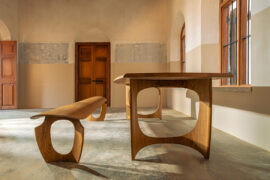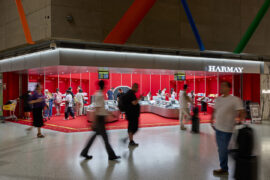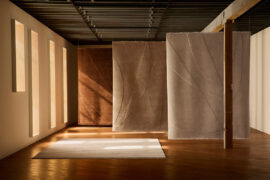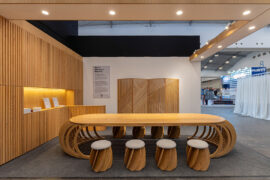In this second part of a series on Brickworks, we move on to the future of brick. Exciting innovations are taking place, pushing design and material technology in new directions.

Gehry Partners, UTS Dr Chau Chak Wing Building, Bowral 76 Limousin Gold and Bowral Shapes Limousin Gold, photography by Jacqui Dean.
October 27th, 2022
In the world of bricks, contemporary innovations are astounding, with sustainability driving radical experimentation and results. At Cape Town university, researchers have created bio-bricks that don’t need to be fired and therefore produce no carbon emissions. Combining human urine with loose sand and bacteria in a brick-shaped mould, a microbial carbonate precipitation triggers a reaction similar to the processes of seashell formation.
Similarly, in America, University of Colorado researchers led by Professor Wil Srubar have developed a process using an organic material that can be moulded into shapes, including bricks. Combining cyanobacteria, warm water, sand, gelatine and nutrients, microbes form and cement the sand together. As living bricks, the bacteria absorbs carbon dioxide, but they are not quite there yet. What is here, however, is a pollution-absorbing Breathe Brick (patent pending) developed by Professor Carmen G. Truddell of California Polytechnic State University. With a self-powered cyclonic separator at its core, the brick sucks in outdoor air to filter and then expel it as clean air indoors.

In Australia Bowral Bricks have constantly developed stronger, safer, more sustainable clay bricks for the past 100 years. Comprised of locally sourced clay, Bowral bricks reflect the rich colours and textures of Australian landscapes, ensuring a seamless integration within Australian homes.
“Bowral Bricks has been a part of Australian life for more than 100 years. With their tactile aesthetic, they have set the standard for design and integrity which has influenced an era of iconic architecture. Their continued commitment to quality ensures Bowral Bricks will remain the benchmark for excellence for many years to come.” says Brett Ward, Brickworks general manager of international marketing.
Related: Brickworks’ Special Shapes

Comprised of the finest quality clays and shales, the minerals are compacted into individual moulds at high pressure to produce solid and dimensionally accurate dry pressed bricks. Bowral’s ability to create sculptured custom shapes has, moreover, provided the opportunity to add individuality to both the interior and exterior of any project — including Frank Gehry’s Dr Chau Chak Wing Building at UTS, where Bowral Bricks Limousin Gold Special Shapes were used to create the iconic ‘paper bag’ facade.
The unique colour variations within each delivery of Bowral Bricks ensures the authentic appeal of traditional manufacturing techniques. From pale Chillingham White and cool silvers through a palette of gold, orange and red hues to the highly sought-after Granite and Bowral Blue, distinctive clay colours and inherent character are the hallmarks of Bowral brick.

To mark their 100th birthday, Brickworks has released a publication: ‘100 Years of Bowral Bricks.’ Documenting the significant milestones in Bowral Bricks’ rich and diverse history, the curated publication celebrates some of Bowral Bricks’ iconic featured projects and the leading architects behind transforming the humble brick into significant Australian landmarks. From the distinctive curves of Koichi Takada’s Arc by Crown to Smart Design Studio’s architectural innovation of Stokes 14, Australian architects have demonstrated the unique ability for brick to deliver unmistakeable character and charm.
Perhaps the greatest testament to Bowral Bricks and their 100 years of continuous brickmaking is the range of incredible projects architects are able to realise with brick. From architectural superstars to local favourites, the variety and complexity of design enabled by brick is extraordinary.
Brickworks
100 Years of Bowral Bricks



The first of this two-part series on Bowral Bricks can be found here
INDESIGN is on instagram
Follow @indesignlive
A searchable and comprehensive guide for specifying leading products and their suppliers
Keep up to date with the latest and greatest from our industry BFF's!
The new range features slabs with warm, earthy palettes that lend a sense of organic luxury to every space.

Architect, designer and craftsman Adam Markowitz bridges the worlds of architecture and fine furniture, blending precision, generosity and advocacy to strengthen Australia’s craft and design community.

With its latest outpost inside Shanghai’s bustling Hongqiao International Airport, HARMAY once again partners with AIM Architecture to reimagine retail through colour, movement and cultural expression.
The internet never sleeps! Here's the stuff you might have missed

Armadillo collaborates with Barcelona artist Carla Cascales Alimbau on Gaia, a sculptural rug collection that translates fine art into handwoven form.

The final instalment in our three-part series on collaborations between the world’s best designers and the American Hardwood Export Council.